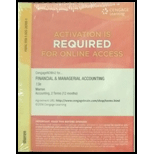
Concept explainers
(a)
Accounts receivable turnover
Accounts receivable turnover is a liquidity measure of accounts receivable in times, which is calculated by dividing the net credit sales by the average amount of net accounts receivables. In simple, it indicates the number of times the average amount of net accounts receivables has been collected during a particular period.
Average collection period:
Average collection period indicates the number of days taken by a business to collect its outstanding amount of accounts receivable on an average.
To calculate: The accounts receivable turnover for Year 1 and Year 2.
(b)
To calculate: The day’s sales in receivables at the end of Year 1 and Year 2.
(c)
To conclude: The Efficiency of Incorporation A’s management in collecting accounts receivables.
Trending nowThis is a popular solution!

Chapter 8 Solutions
CengageNOWv2, 2 terms Printed Access Card for Warren?s Financial & Managerial Accounting, 13th, 13th Edition
- Assume that 800 units were worked on during a period in which a total of 700 good units were completed. Normal spoilage consisted of 50 units; abnormal spoilage, 40 units. Total production costs were $3,600. The company accounts for abnormal spoilage separately on the income statement as a loss due to abnormal spoilage. Normal spoilage is not accounted for separately. What is the cost of the good units produced?arrow_forwardCan you help me solve this general accounting question using the correct accounting procedures?arrow_forwardI need financial accounting answerarrow_forward
- Thurman Industries forecasts that total overhead for the current year will be $13,250,000 with 175,000 total machine hours. Year to date, the actual overhead is $8,420,000 and the actual machine hours are 89,000 hours. The predetermined overhead rate based on machine hours is _. (Round the factory overhead rate to the nearest dollar before multiplying by the number of hours.)arrow_forwardDon't use ai given answer accounting questionarrow_forwardCan you explain the process for solving this financial accounting question accurately?arrow_forward
- Dixon Corp. has a contribution margin ratio of 40%. The company is considering a proposal that will increase sales by $200,000. What increase in profit can be expected if fixed costs increase by $50,000? A. $60,000 B. $70,000 C. $80,000 D. $30,000arrow_forwardCan you provide the valid approach to solving this financial accounting question with suitable standards?arrow_forwardI am searching for the accurate solution to this general accounting problem with the right approach.arrow_forward
 Financial AccountingAccountingISBN:9781305088436Author:Carl Warren, Jim Reeve, Jonathan DuchacPublisher:Cengage Learning
Financial AccountingAccountingISBN:9781305088436Author:Carl Warren, Jim Reeve, Jonathan DuchacPublisher:Cengage Learning Financial AccountingAccountingISBN:9781337272124Author:Carl Warren, James M. Reeve, Jonathan DuchacPublisher:Cengage Learning
Financial AccountingAccountingISBN:9781337272124Author:Carl Warren, James M. Reeve, Jonathan DuchacPublisher:Cengage Learning Managerial AccountingAccountingISBN:9781337912020Author:Carl Warren, Ph.d. Cma William B. TaylerPublisher:South-Western College Pub
Managerial AccountingAccountingISBN:9781337912020Author:Carl Warren, Ph.d. Cma William B. TaylerPublisher:South-Western College Pub Financial And Managerial AccountingAccountingISBN:9781337902663Author:WARREN, Carl S.Publisher:Cengage Learning,
Financial And Managerial AccountingAccountingISBN:9781337902663Author:WARREN, Carl S.Publisher:Cengage Learning, EBK CONTEMPORARY FINANCIAL MANAGEMENTFinanceISBN:9781337514835Author:MOYERPublisher:CENGAGE LEARNING - CONSIGNMENT
EBK CONTEMPORARY FINANCIAL MANAGEMENTFinanceISBN:9781337514835Author:MOYERPublisher:CENGAGE LEARNING - CONSIGNMENT





